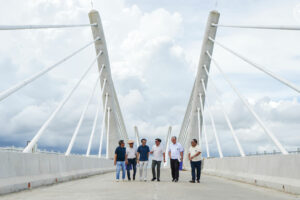PHILIPPINE President Ferdinand R. Marcos, Jr. on Tuesday directed government agencies to implement a nationwide master plan for farm-to-market roads, saying the system must be reformed to ensure that infrastructure truly supports farmers and boosts agricultural output.
Speaking in Claveria, Cagayan during his Ugnayan with Farmers dialogue, he said the government has finalized a plan, mapping priority areas for road construction and rehabilitation.
“We’ve already drawn up a plan for the entire Philippines,” he said in Filipino, according to a livestreamed video on the Radio, Television, Malacañang Facebook page.
“We will also meet with our mayors and governors to ask if our plan is good, if the proposed routes for the farm-to-market roads are correct, and to hear their suggestions — which we will follow in implementing the plan.”
In a separate press briefing, Palace Press Officer Clarissa A. Castro said the plan will be rolled out immediately but did not elaborate on the details.
“He wants this done quickly. Before his term ends, he wants the project to already be completed. In fact, he hopes it will be finished before Christmas,” she said in Filipino.
The President emphasized the new plan would not cater to favoritism.
“Not like before, when it was all about favoritism. People would make requests like, ‘Put a farm-to-market road here,’ and if they were friends or party mates, it would get approved. There was no real plan. Sometimes, farm-to-market roads were built in random places that didn’t even help our farmers.”
The initiative, led by the Department of Agriculture (DA), the Department of Public Works and Highways (DPWH), and the National Irrigation Administration (NIA), aims to improve logistics efficiency and strengthen rural value chains.
Farm-to-market road initiatives have drawn corruption criticisms following the emergence of ‘ghost’ projects, widening the Philippines’ ongoing probe on public work scams.
Mr. Marcos on Monday also ordered an investigation into reports of seven ghost farm-to-market road projects in Davao Occidental worth P105 million.
The DA has submitted its findings to the President, leading to coordination between Agriculture Secretary Francisco P. Tiu Laurel, Jr. and Public Works Secretary Vivencio B. Dizon to probe the issue.
WATER IMPOUNDING DAMAlso on Tuesday, Mr. Marcos led the inauguration of the P500-million Union Water Impounding Dam in Claveria, Cagayan, a flagship infrastructure project aimed at improving irrigation, flood control and climate resilience in northern Luzon.
The project, built across the Cabicungan River in the villages of Union and Cadcadir, is expected to irrigate more than 1,050 hectares of farmland and benefit over 1,000 farmers, according to Mr. Marcos’ office.
It features slope protection and drainage systems designed to reduce river siltation and erosion while preventing flooding in agricultural zones.
The Union Dam forms part of the DPWH’s Katubigan program, implemented in partnership with NIA.
It is one of several water impounding projects in Cagayan, including those in the villages of Tabbugan and Bacsay, which together are projected to serve more than 3,000 farmers across the province, NIA Region 2 spokesperson Paula M. Pereña said, according to a statement from Mr. Marcos’ office.
CAMALANIUGAN BRIDGEMr. Marcos also inspected the nearly completed Camalaniugan Bridge in Cagayan, describing it as one of the country’s most visually striking and well-built bridges.
Once operational, the cable-stayed bridge—the longest of its kind in Cagayan Valley—will link the municipalities of Aparri and Camalaniugan, cutting travel time between Aparri and Ballesteros from one hour to just 20 minutes.
The bridge is expected to serve about 6,000 travelers daily.
The Camalaniugan Bridge, which began construction in May 2020, is 99% complete as of September 30, according to Mr. Marcos’ office.
The new structure will serve as an alternate route to the Magapit Suspension Bridge—currently the only crossing over the Cagayan River in the area—and is expected to ease traffic, boost trade, and lower transport costs for goods and commuters.
Mr. Marcos noted that the bridge’s completion would complement the nearby Aparri Port, facilitating faster cargo movement across northern Cagayan. — Chloe Mari A. Hufana
